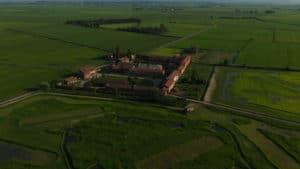
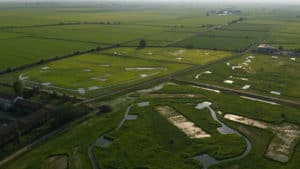
“When the paddy field is flooded, especially in the spring, it is then that the rice landscape offers its most spectacular aspect: the reflections of the sky, trees, mountains and farmhouses create optical effects as in a mirror, the farmhouses themselves look like islands in a beautiful lagoon.”
–Alice Cerutti, of Cascina Oschiena
I’m right there in the cab of the gray Toyota truck with Alice (Ah-leach-ay) Cerutti behind the wheel, bouncing over the dirt roads from one part of the farm to another. The fields of tall green rice plants whiz by, patchworked with water-filled stone canals lined with trees and shrubs. The Apennines Mountains span the distant horizon, their snow-capped peaks in contrast to the high August heat and humidity on the vastness of the farm.
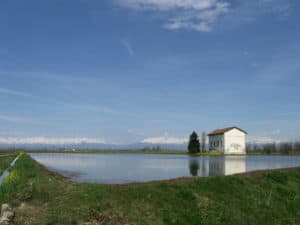 But of course, I’m not in the cab of Alice’s Toyota. She is in the province of Vercelli, Piedmont in Italy and I am in the small city of Portland, Maine, USA.
But of course, I’m not in the cab of Alice’s Toyota. She is in the province of Vercelli, Piedmont in Italy and I am in the small city of Portland, Maine, USA.
Like so many others in 2020, we are on a Zoom call, and I am getting a tour of her rice farm, Cascina Oschiena. It’s on land Alice’s grandfather bought in the 1950s and had always rented out until 2008 when, with the support of her husband and mother, Alice became the first generation of active farmers in her family. Perhaps, Alice says, one day her now two-and-a-half-year old son, Mario (named after her grandfather) will farm this land, but only if he has a love for it, she adds.
On our way to a field of Carnaroli rice, Alice slows the truck and pauses to say hello to her companion horse, Grisù, from her open window. Then we pick up speed and she continues talking about the history of the land.
 “Cascina” means “farmhouse” in Italian and Cascina Oschiena is just that, in the truest sense. The farmhouse and grounds originally date back to the 16th century as the site of Benedictine Monks and the Abbey of Santo Stefano di Vercelli.
“Cascina” means “farmhouse” in Italian and Cascina Oschiena is just that, in the truest sense. The farmhouse and grounds originally date back to the 16th century as the site of Benedictine Monks and the Abbey of Santo Stefano di Vercelli.
Alice Cerutti has maintained the character of the 16th century Abbey as “testimony to the past.” The buildings that were once home to riders, blacksmiths, carpenters and mondine (seasonal rice paddy workers) still stand, while she is making significant modern renovations and implementing farming practices aimed at restoring biodiversity and giving back to the land.
Did Alice always know this would be her path–to become a rice farmer on her family’s land? Not until she did, with great and blinding clarity.
After studying economics at University, Alice worked as an intern in New York City, later moving back to Italy to work in the marketing department of the Ferrero Company, second biggest chocolate producer in the world. Alice spent her weekends at the family farm and a shift began to happen for her. What life did she see for her future?
In 2008, Alice got the call for change, literally.
Her mother called her one night on the phone. She told Alice that her aunt and uncle were selling the farm.
“I got a stomach ache,” Alice recalls. “I had to try at least; it was right to do it. At the beginning…I thought of doing both ‘jobs’”-Alice is clear farming is not a job, rather a passion- “Then I understood…the importance and significance of food, the idea of being the guardians of the territory, landscape and environment.”
 Since that fateful phone call, Alice has become the vice president of the European Council of Young Farmers and a member of Ecorice, a project focused on fostering biodiversity by restoring ancient rural landscapes. She received her diploma of professional rice tasting from Acqua Verde, a company that promotes the culture of Italian rice through sensory analysis.
Since that fateful phone call, Alice has become the vice president of the European Council of Young Farmers and a member of Ecorice, a project focused on fostering biodiversity by restoring ancient rural landscapes. She received her diploma of professional rice tasting from Acqua Verde, a company that promotes the culture of Italian rice through sensory analysis.
 And, notably, after four years of planning with Ente Parco del Po Vercellese-Alessandrino (a management body for protected areas in that part of Piedmont), as well as an extensive team of botanists, bird experts, naturalists, entomologists and herpetologists, the Nature Wetlands of Cascina Oschiena project has converted 25 hectares from rice cultivation to a nature preserve. It is the first Italian rice producer to obtain the Friend of the Earth Certification which ensures the farm has “an efficient environmental and social management system in place.”
And, notably, after four years of planning with Ente Parco del Po Vercellese-Alessandrino (a management body for protected areas in that part of Piedmont), as well as an extensive team of botanists, bird experts, naturalists, entomologists and herpetologists, the Nature Wetlands of Cascina Oschiena project has converted 25 hectares from rice cultivation to a nature preserve. It is the first Italian rice producer to obtain the Friend of the Earth Certification which ensures the farm has “an efficient environmental and social management system in place.”
The many animal species now thriving on the land are further evidence that Alice has restored the ancient ecosystem. The farm is currently home to amphibians, dragonflies, butterflies and 145 species of migratory birds, namely the Blacktailed Godwit. Cascina Oschiena is the only recorded nesting site in Italy for this long-legged and long-billed bird, which not only graces the land of Cascina Oschiena, but also its labels as the company’s logo.
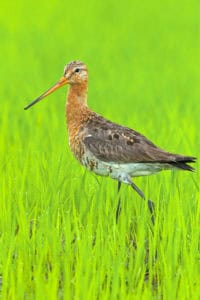 The historical method of farming through flooding dates back over 500 years on Cascina Oschiena. It is the critical element of creating this wetland environment where so many species thrive. Each spring, the ice melt from the Apennines mountains fills the local rivers (including the Po River–the longest river in Italy) and the spontaneous springs of Cascina Oschiena. Alice says, “Early flooding allows the slowing down of water streaming from the mountains…to the sea, safeguarding water availability.” These seasonally replenished waters are the source for flooding the fields for sowing. The water reaches the farm and fills the fields by way of a gravity-based system comprised of various artifacts such as dykes, stone canals, dams, bulkheads, locks and joints rather than gasoline-powered equipment. Because the rice fields remain flooded from late March through mid-August, the plants do not require constant irrigation procured by mechanically pumped water, which is a real taxation on the water supply and the environment.
The historical method of farming through flooding dates back over 500 years on Cascina Oschiena. It is the critical element of creating this wetland environment where so many species thrive. Each spring, the ice melt from the Apennines mountains fills the local rivers (including the Po River–the longest river in Italy) and the spontaneous springs of Cascina Oschiena. Alice says, “Early flooding allows the slowing down of water streaming from the mountains…to the sea, safeguarding water availability.” These seasonally replenished waters are the source for flooding the fields for sowing. The water reaches the farm and fills the fields by way of a gravity-based system comprised of various artifacts such as dykes, stone canals, dams, bulkheads, locks and joints rather than gasoline-powered equipment. Because the rice fields remain flooded from late March through mid-August, the plants do not require constant irrigation procured by mechanically pumped water, which is a real taxation on the water supply and the environment.
The water management system at Cascina Oschiena holds valuable social and strategic functions. The irrigation network is a buffer during the floods which ensures the availability of water to those territories even in drought situations. “The paddy fields filter the water,” says Alice, “refilling the groundwater aquifers and springs that guarantee potable water kilometers downstream.”
Alice says of the ancient flooding method, “It’s renewable–I give [the water] back through the dykes….Water is life for us, for biodiversity, for rice and its territory and landscape.”
Yet another benefit of flooded sowing is the temperature moderation allowed by this water “blanket.” “Historical varieties like Classic Carnaroli and Classic Arborio could very hardly germinate and grow without water because [they are] extremely…sensitive to temperature changes,” Alice says. During the submersion stages, the chambers are kept level to ensure homogenous depth of water and consistent temperature. “I look after the water like I do my child—morning and night,” Alice says.
 The elements of the historical farming practices used at Cascina Oschiena stand in stark contrast to the more modern industrial system of “dry” farming which not only requires extensive and constant watering during the growing season (which maximizes yield but depletes water sources) but also makes an inhospitable environment for local animal, insect and amphibian species.
The elements of the historical farming practices used at Cascina Oschiena stand in stark contrast to the more modern industrial system of “dry” farming which not only requires extensive and constant watering during the growing season (which maximizes yield but depletes water sources) but also makes an inhospitable environment for local animal, insect and amphibian species.
The tires crunch to a stop on gravel. Alice hops out of the truck and we head toward a rice paddy. She grows several varieties including Carnaroli, Arborio, Apollo and more. We are headed to a field of Carnaroli.
She pauses in front of a white stucco and brick church. It’s the Madonna del Tabalino, one of the original structures of the Abbey of Santo Stefano di Vercelli.
“I got married here on a hot day in July five years ago,” Alice recalls. “What was I thinking getting married in July?” she laughs. “It was so hot. 38 degrees in Celsius. I don’t know what that is in Fahrenheit.”
I didn’t know either so I googled it. It’s 100.4. Yikes.
Next to the church is a small pond. Alice explains there is a natural spring in the pond which supplies water to the paddy fields. She shares the legend that over 500 years ago a girl who was mute saw, at the bottom of the pond, the statue of Saint Mary and began to scream with excitement. In honor of this special day on which Saint Mary was discovered and a young girl found her voice, the people built the church and named it after Saint Mary (Madonna).
“The tradition is still alive today,” says Alice. “Every 2nd [of] July, there is a Holy Mass to give thanks to la Madonna del Tabalino. After the Mass we cook a Risotto–Panissa, the typical Vercelli Risotto.” This risotto is made with Carnaroli rice, smoked pancetta, cured meats, borlotti beans, tomatoes & red wine.
 “Oh, look at the rabbit!” Alice says, and turns her phone just as a little rabbit hops into the bushes, which seems like it would be a relatively normal site. But many modern rice farms are typically void of trees and other plants, while ancient Italian rice farms abounded with native flora. Alice has planted over 5,000 Piedmont-native shrubs and trees on Cascina Oschiena.
“Oh, look at the rabbit!” Alice says, and turns her phone just as a little rabbit hops into the bushes, which seems like it would be a relatively normal site. But many modern rice farms are typically void of trees and other plants, while ancient Italian rice farms abounded with native flora. Alice has planted over 5,000 Piedmont-native shrubs and trees on Cascina Oschiena.
Then we are moving again; she is walking and talking fast. I attribute it to our limited time on Zoom, but I think it’s more than that: she is passionate, energetic and always on the move–to improve, share information and cultivate community—but never too busy to pause to say hello to her horse or share a story.
As we hustle to the field of Carnaroli, she points to her neighbor’s farm. Recently she removed an old wall that delineated her property from her neighbor’s, its construction dating back to a feud between two brothers who owned the land long before Alice’s family. Tearing down a wall so aptly sums up her commitment to work cooperatively with surrounding farmers and the food industry.
“Network is one of the key elements I see in our future. Farming today is much more than just producing food,” says Alice later in an email. “It is the environment, climate, innovation, research, marketing, accountability, lobbying. This is why it is so important to learn and exchange best practices with other farmers near and far.”
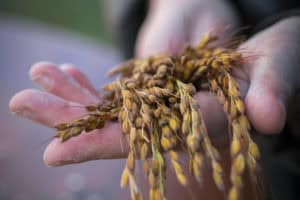 But it has not been an easy road to go against the proverbial grain. “It continues to be not always easy to be accepted by farmers that for generations have always been farming in the same way with the only aim of maximizing production yields and revenues,” Alice says.
But it has not been an easy road to go against the proverbial grain. “It continues to be not always easy to be accepted by farmers that for generations have always been farming in the same way with the only aim of maximizing production yields and revenues,” Alice says.
There is a shift happening, she explains. On one hand, CAP (Common Agricultural Policy)—European subsidies for the Farming Sector–is moving toward “greener” policies which requires a change in the industry mentality. However, Alice says, “I think that also on a voluntary level the mentality of some farmers is changing. They are starting to acknowledge the importance of …farming more sustainably, respecting more the environment and territory.”
Some of the biggest original skeptics have recently come to Alice for advice. “Like my neighbors,” she says, “You can’t imagine how happy it makes me feel. I always tell my colleague farmers that it is important to take a step at a time… just planting a couple of trees or sowing in water just a single field of their farm. Our gates are always open for tourists, children, customers… and of course, also for farmers.”
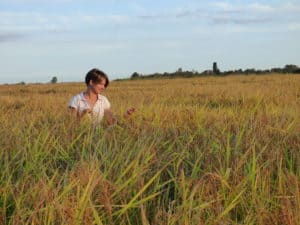 And Alice says she has not only offered resources, information, and help; she has received all of those things. “We would not be able to have achieved our dream of The Nature Wetlands Project without our fantastic team of Parco del Po, Vercelli Province, botanists, bird experts and naturalists,” she says. “Another example…is the technical help I had from other young farmers especially at the beginning. Advice that I still sometimes ask for today.”
And Alice says she has not only offered resources, information, and help; she has received all of those things. “We would not be able to have achieved our dream of The Nature Wetlands Project without our fantastic team of Parco del Po, Vercelli Province, botanists, bird experts and naturalists,” she says. “Another example…is the technical help I had from other young farmers especially at the beginning. Advice that I still sometimes ask for today.”
“It is wonderful to feel helped, too,” she says.
We arrive now in a field of Carnaroli rice, in August nearing harvest time the green reed-like rice reaches Alice’s shoulders. “I’m not that tall, but it will become taller than me,” she says.
Let us take a moment to talk about the rice varieties grown at Cascina Oschiena. The varieties include certified Classic Carnaroli and Classic Arborio (more in a moment on how special certified Classic varieties are); as well as Apollo, Carnaroli Brown, Selenio and Venere (and a wheat varietal, Ancient Diccocum Spelt).
The rice varieties fall into one of two classifications which indicate taste and texture attributes: Japonica rice and Indica rice. The Classic Carnaroli, Classic Arborio and Venere varieties are Japonica rice which have higher levels of the noncrystallizable form of starch called amylopectin and lower levels of amylose, the crystallizable form of starch, making for a rice that cooks up softer and more creamy, the type often used for making risotto. Risotto recipe options are limitless, but I will leave with you just a favorite or three of Alice’s. If you prefer a lighter, easier risotto than the Panissa with pancetta and cured meats, Alice suggests risotto with local goat cheese and beet. Or toma cheese, nuts, and red wine. Or sausage, mushrooms, and white wine. “Or I can think of more!” Alice says.
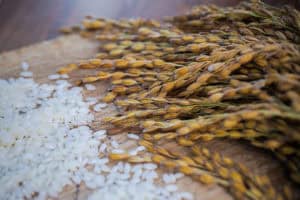 The Apollo variety–an indica rice– has less amylopectin and more amylose making for a grain that is fluffier and more separate. With a lovely fragrance, this rice is great with meat and fish dishes or, as with many great foods, delicious on its own–try it with a little extra-virgin olive oil or vegetables.
The Apollo variety–an indica rice– has less amylopectin and more amylose making for a grain that is fluffier and more separate. With a lovely fragrance, this rice is great with meat and fish dishes or, as with many great foods, delicious on its own–try it with a little extra-virgin olive oil or vegetables.
So, here’s what makes Certified Classic rice varieties so special and rare. Firstly, what makes a rice Classic? Classic varieties, such as Cascina Oschiena’s Arborio and Carnaroli, are historical and authentic varieties certified as such by the Ente Nazionale Risi, an institution supervised by the Ministry of Agricultural Food and Forestry Policies and held responsible for the conservation of Carnaroli and Arborio rice. These historical varieties are barely grown anymore. In fact, the Classic Ricegrowers Professional Register just uploaded its 2020 list of farms that sow the Historical Classic Arborio and Cascina Oschiena is one of only FIVE!
“It is so important to underline and explain how unique the ancient varieties are,” Alice says. “Their height is amazing. The plant is a beautiful green, strong, thick and wide…so rich in dimension because [they] were born to be competitive by themselves before the intensive industrial agriculture became widespread. Their grains are beautiful; big, round, pearled. In the paddy fields the grains have a unique red burnished color; the modern varieties are all pale yellow and straw-colored.”
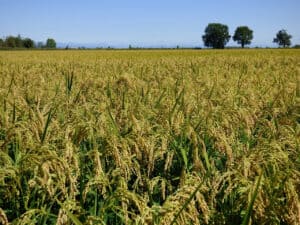 She adds, “The modern technologies and crossbreeding led to better rice plants in terms of production yield and easier cultivation methods, but the taste, the quality of the grains and the cooking properties are not even comparable.”
She adds, “The modern technologies and crossbreeding led to better rice plants in terms of production yield and easier cultivation methods, but the taste, the quality of the grains and the cooking properties are not even comparable.”
Alice explains this to me in an email exchange, but on our Zoom tour she stood in that field of Carnaroli up to her shoulder, soon to exceed her height, marveling at the arista–the long, red whisker-type tassel at the top of the plant–unique in its color and not seen in many other paddy fields. Only moments ago, we had been barreling along in her truck with a sense of urgency to see the whole farm in a 40 minute Zoom call, but pausing here in the field to delight in her plants, Alice seems like she has all the time in the world.
I do not know how else to explain the way she talked about the rice plants, the farm, the animals, the projects aimed at biodiversity: she is in love.
The tall green plants audibly brush against Alice as she strides through the field. She pauses to point out red dragonflies darting among the plants.
Next, we jump a ditch of water into the open door of the truck and drive off to visit another field of rice–Arborio this time. Alice puts the phone on the dashboard, and we start driving, the cloudless blue sky above and green fields a blur.
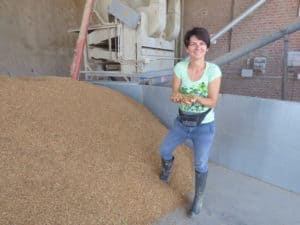 What happens after the rice is grown and cultivated? The milling and treatment of rice post-harvest is equally important to the quality as the growing.
What happens after the rice is grown and cultivated? The milling and treatment of rice post-harvest is equally important to the quality as the growing.
Alice personally does the slow drying procedure of the rice in the drying kiln. The temperature does not exceed 34 degrees Celsius (normally it is the 50-60) and it can take Alice over 36 hours to dry the rice which lends an excellent cooking resistance, grain consistency and taste.
Next, the rice is “soft” milled, a gentle process in which the germ of the rice is not totally removed (as with most industrial milling processes) keeping intact the vitamins, minerals and fiber of the rice. The mill uses stone milling machines called “Zanotti,” similar to the ancient, traditional stone milling machines called “Amburgo.” “The rice…is only ‘caressed,’” says Alice. “[This keeps] intact all the organoleptic and nutritional properties.”
Currently, the milling is outsourced to a local company. “Our goal is to have our own mill,” says Alice, “but… only when we will be able to afford the same excellent machinery.” The mill uses optical machinery that guarantees the purity and traceability of the rice as well as complete removal of all foreign matter such as stones and straw.
Alice says, “I see when and how they mill our rice: the hygiene, the expertise, the accuracy they have is extraordinary.” She adds, “They understand and acknowledge how much I care for the quality of our product. I require less than 1% of broken rice–the Italian law says 5% is the limit… this is why…they always tell me I am the most ‘pignola’ of their clients. ‘Pignola’ means very, very picky, precise, and demanding. Of course [they say this] in a polite way.”
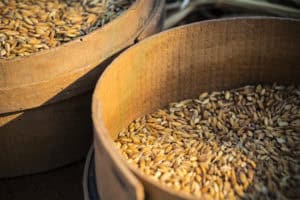 The low percentage of broken rice means homogeneity of the grains which allows for increased excellence in cooking properties and resistance.
The low percentage of broken rice means homogeneity of the grains which allows for increased excellence in cooking properties and resistance.
Alice is passionate, knowledgeable, and driven, but she is far from having a chip on her shoulder. “I really don’t want to seem ‘stuck-up’ but I really believe in the uniqueness of our projects and the importance of farming in symbiosis with nature, biodiversity, quality of water.” She adds, “I’m not too radical or against the industry but we have to have more respect for the environment.”
What’s Alice’s continued vision for the future?
“It would be amazing if we could achieve some of the Environmental projects on which I am working with a network of farmers,” she says, “to be able to create Ecological Areas, and maybe promote them together for schools and tourists. This is the Future I would love to see.”
Written by Leska Tomash
CLASSIC CARNAROLI RICE CO3000 1KG
CLASSIC ARBORIO RICE CO2000 1KG